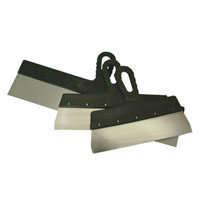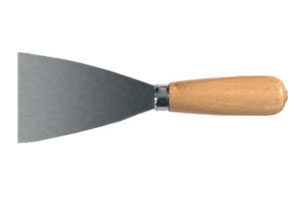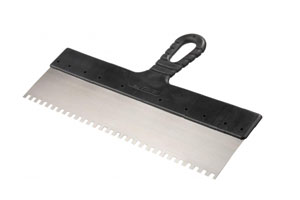 In this article we want to talk about such a simple, but important finishing tool as a spatula. Without it, it is impossible to perform most plastering, painting and other works. Externally, the spatula is a flat, wide steel blade fixed in a plastic or wooden handle. The exception is rubber spatulas.
In this article we want to talk about such a simple, but important finishing tool as a spatula. Without it, it is impossible to perform most plastering, painting and other works. Externally, the spatula is a flat, wide steel blade fixed in a plastic or wooden handle. The exception is rubber spatulas.
Holding the handle with a steel plate, the finishing material is hooked and applied to the wall or work plane. With smooth movements in the future, the applied mass is leveled with a uniform layer. The wider the spatula, the higher the efficiency and the volume of work performed. In the article we will talk about flat spatulas, without affecting the design of angular and curly ones. But now let's dwell on the different types of spatulas in more detail.
1. Plaster spatula. In fact, this is just the classic type of spatula that we talked about above.
Plaster spatulas are designed for applying various plaster compositions, putties and adhesives on various surfaces. They are distinguished by a smooth surface of the blades and a smooth edge. The blades of these spatulas have a triangular, rectangular or trapezoidal shape. Depending on the size, these spatulas are divided into front (wide) and spatula - spatula. The purpose of the spatulas is the same, just the front ones are wider and are designed to process large surface areas.
The shape of the blade may differ slightly, but let's say right away that if it is teardrop-shaped or triangular in shape, then it is very inconvenient to take a plaster mortar or putty from a bucket.
Plaster spatulas come in a wide variety of widths, ranging from narrow (20-30 mm) to wide ones up to 500 mm. Usually plasterers have a whole set of spatulas of different widths in order to use the most convenient one for one purpose or another. 
2. Rubber spatula. This is a special type of spatula designed to apply grout into the joints between ceramic tiles. A feature of this spatula is that it is made entirely of rubber and has the appearance of a thick rubber blade with a rectangular shape. The fact is that this type of work cannot be done with an ordinary spatula. The steel blade will simply scratch the tile. In addition, due to the natural bending of the rubber spatula, the top layer of grout is removed and the seam is slightly below the level of the tile itself.
In the process of using this type of spatula, it is necessary to periodically wipe it off the grout so that it does not seize, otherwise it will be difficult to wash later and, most importantly, the seized pieces of grout will scratch the new seam.
3. Spatula for tiles. In appearance, this tool resembles a simple plaster, or rather a facade spatula, with one exception. The end edge of this type of spatula has uniform slots. The result is that the edge of the spatula has rectangular teeth. Since the spatula is intended for applying adhesive compositions to the tile or base when it is laid, due to these teeth, the adhesive is applied in the form of strips. This allows you to evenly distribute the adhesive over the entire surface of the tile, as well as significantly save adhesive material.
Spatulas for tiles come with different tooth heights, which are selected depending on the thickness of the laid ceramic tiles or porcelain stoneware.
Other hand painting tools
|
Useful articles |